If in Turin you have strolled along the avenues of the Valentino Park, you will surely have happened to see towers, Ghibelline battlements, three-mullioned windows, and porticoes standing out among the trees that color the banks of the Po: well, you have arrived in the charming Borgo Medievale! As soon as you cross the drawbridge, you find yourself for a moment bewildered: yes, because until just before you were convinced that the vestiges of medieval Turin still remaining today were very few, and were on the opposite side of the city, in the so-called "Roman Quadrilateral." Then, after settling in and reading about the history of the suburb, you will understand (and your previous beliefs will be confirmed) that you are not in a real medieval suburb, that is, it is not a complex of buildings dating back to the Middle Ages. The history of this site is in fact very interesting.
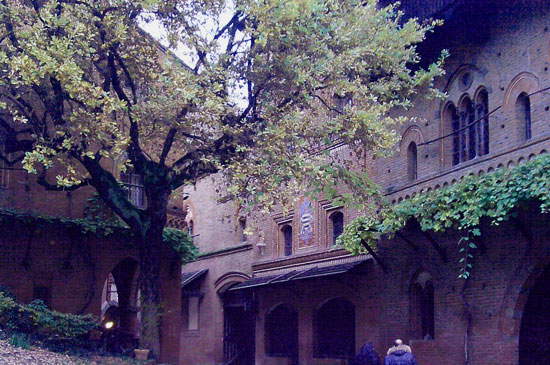 |
| The Medieval Village of Turin |
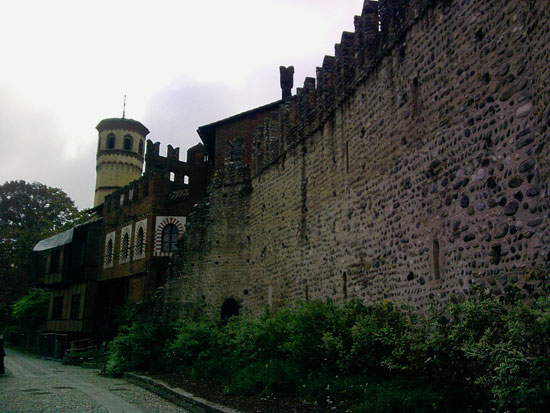 |
| The walls of the Medieval Village of Turin |
We have to go back to 1884, when theGeneral Italian Artistic and IndustrialExhibition was held in Turin. Already at that time, Turin had lost much of its medieval soul: the idea was therefore born to reconstruct, in a faithful way, a 15th-century Piedmontese medieval village to bring Torinese (and Italians) back to that era of which the modern city now retained few memories. The idea came from the archaeologist Alfredo d’Andrade, Portuguese but Italian by adoption, and a specialist in medieval architecture: a person therefore particularly suited for the project of reconstructing a centuries-old village. Alfredo d’Andrade gathered a team of fine art connoisseurs, painters, architects, historians and engineers, who finished their work just in time for the inauguration, which took place on April 27, 1884. That village garnered so much acclaim that it was not dismantled, as it was originally intended to be, but was maintained, embellished and constantly enriched, and is still one of the city’s most fascinating attractions today.
The uniqueness of this village lies in the fact that it is not a fictitious reconstruction, but rather a kind of “collage” of real existing buildings all belonging to the same era, which have been arranged around a main street, alleys and small squares to give us an idea of what a medieval Piedmontese village really looked like in the 15th century. And we assure you that the intention has been carried out perfectly, carefully respecting every detail. We notice it immediately upon our arrival: in fact, to enter the village we have to cross a drawbridge that leads us to the access tower. The latter is a reconstruction of the Ricetto Tower, which is located in Oglianico, near Turin. Only the pictorial decorations have been added, which instead derive from the castle of Malgrà, near Rivarolo Canavese.
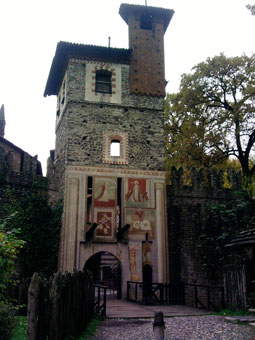 |
| The access tower of the Borgo Medievale di Torino, which was inspired by the tower of the ricetto of Oglianico, near Turin |
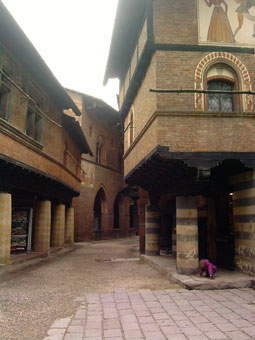 |
| The main street of the Medieval Village of Turin: on the left the Pilgrims’ hotel and on the right the house of Bussoleno |
So here we are immediately in the main street of the village, with its buildings. On our right we find the house of Bussoleno, a building inspired by a construction that actually existed in this town in the Susa Valley: on the ground floor are workshops of artisans that help to immerse us even more in the reality of the medieval village. Here we can find prints and small paintings depicting characteristic corners of the village or Piedmontese villages. On the left, on the other hand, we have a reproduction of a pilgrims’ inn, where in ancient times wayfarers stopped on their way to pilgrimage sites: again, the building is inspired by examples we find in the Cuneo area. Near the Bussoleno house we also have a small square with a fountain: it has a rectangular stone basin, bears the date 1484 in Roman characters, and is a typical fountain of the villages of the Piedmontese Middle Ages. These fountains were found almost everywhere in Piedmont and were used not only to give water to the population, but also to water the horses.
Continuing on and leaving behind the arcades with their stores, businesses and decorated wrought-iron signs, we cannot fail to stop in the small church square: the sacred building is one of the most interesting in the village. Initially, the designers conceived only the facade, but in more recent times the body was also added, which is now used as a venue for exhibitions and displays. The facade is inspired by that of the Cathedral of Ciriè, of which the ghimberga (i.e., that kind of pediment above the main portal) is a faithful reproduction. Other elements, such as the decorations on the cornices and windows, are taken from other churches in the provinces of Cuneo and Turin. We also note frescoes: an Annunciation above the main portal, and a St. Christopher carrying Baby Jesus on the side corresponding to the right aisle, while on the opposite side we find a figure of St. Bernard holding the devil in chains-all frescoes that actually exist in churches in Piedmont.
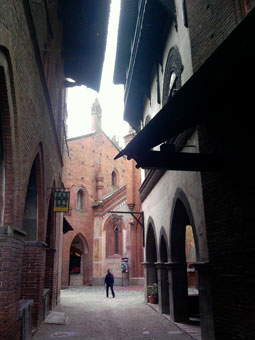 |
| The main street with the church in the background |
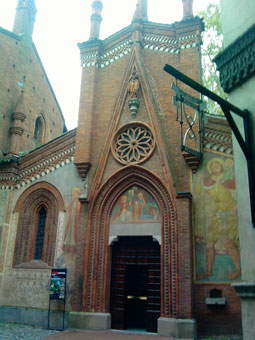 |
| The church in Turin’s Borgo Medievale |
Continuing our walk, and leaving behind us buildings such as the Mondovì House, a 14th-century palace inspired by a 14th-century aristocratic residence in the Piedmontese town, one of the most interesting in the borough, and after taking a look at the inner courtyard, on which the tower of Avigliana is silhouetted against the waters of the Po, we will see the outline of the Rocca rising to our right, in a dominant position compared to the rest of the borough. It is the residence of the local lord, and here not only the exterior has been reconstructed in great detail, but also the interior, so much so that it is the only building in the borough that can be visited in its entirety, in all its rooms: the kitchens, the armorers’ rooms, the throne room, the prisons, and the chapel. It is also the only area of the borough that can be visited for a fee (in fact, we did not tell you that you can enter the Medieval Borough of Turin for free!). However, we advise you to plan your visit in advance, because you can only enter the Rocca accompanied by the museum staff, groups are limited in number, and the hours are staggered with very high precision. We, for example, didn’t visit the Rocca because we arrived a handful of minutes after the accompanied tour began, and we didn’t have time to wait for the next one...so be prepared against such inconveniences :-)
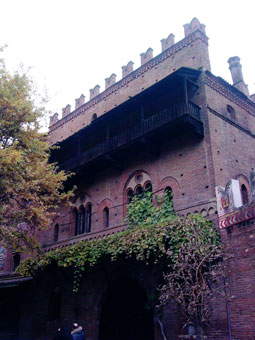 |
| The House of Mondovi/tr> |
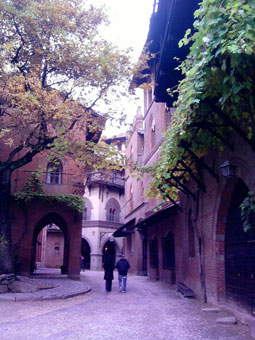 |
| Street church of the Medieval Village of Turin |
So there is nothing left to do but to retrace the narrow streets of the borough, amidst the leaves falling from the foliage of the plants and the cold wind creeping through the porticoes, in the unreal silence of a medieval town built a few meters away from the chaos of the metropolis.
Warning: the translation into English of the original Italian article was created using automatic tools. We undertake to review all articles, but we do not guarantee the total absence of inaccuracies in the translation due to the program. You can find the original by clicking on the ITA button. If you find any mistake,please contact us.